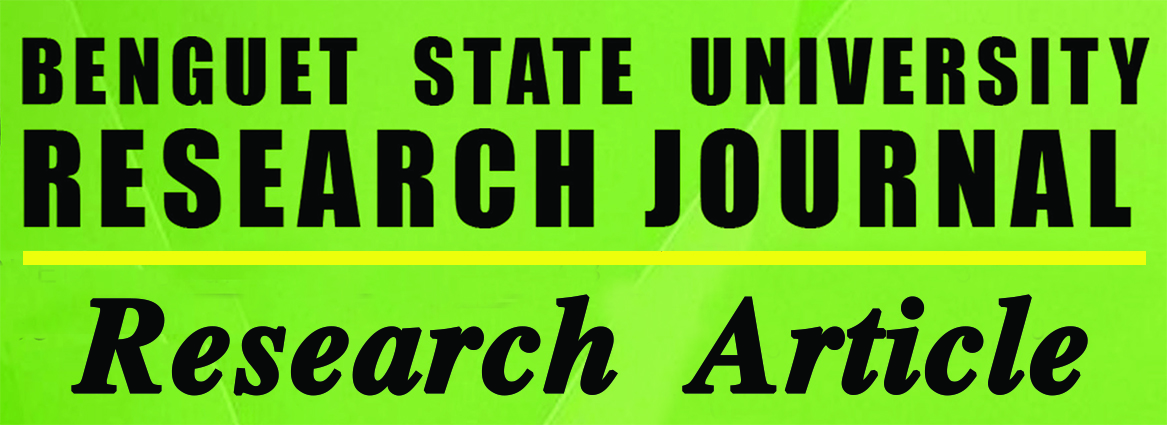Kinds, Uses, and Implications of Woven Ethnic Materials of The Benguet People
Main Article Content
Abstract
Ethnic clothes and blankets are important elements of the Cordilleran culture. Benguet tribes of the Northern Philippines have a high regard for the woven ethnic costumes and blankets, as an identity of their culture. This study aimed to document the historical background of the woven ethnic materials in Benguet Province, Philippines; the different kinds, uses and implications of these ethnic woven cloths; and the potentials of improving them.
The different woven ethnic materials of the Benguet tribes are blankets and the clothes worn by 1nen and \Vornen. There are two 1najor tribes of Benguet that were considered in this study, the Kankana-eys and Ibalois. These two tribes have the san1e attires and clothes but differ in the local tenn. Major blankets are the pinagpagan, dilli/shendi, kuabawlsarong, bayaonglkoieba>t\ and bandala!safey. The aiahdang, which used to be the blanket for the very rich, is seldon1 used. Other blankets like n1anta and adefus are the co1nn1on ones. The ,nabli was used in the later years, mostly by the Kalanguyas, another Benguet tribe. The different kinds of blankets implies the social status of the user. The social status can be inherited or acquired and have sub-levels that are determined by the number of eyes/eyelets embedded in the designs of the blankets.
The won1en's costume is a pair of tapis, which is composed of a wrap-around skirt and blouse (ka,nbal or sa,nbra). There are different kinds of color co1nbinations of the tapis, while the ordinary one is a co1nbination of the black and white. For the Kankana-ey tribes, aside frotn the cotnmon tapis, they also have another design called lamma. For the men, they wear G-string (kubalkuval). The Kankana-eys have different kinds of kuba: the baa, binoltong, pillac, pinangsas and sinulan1a11. The Ibaloi's kuval are the pinangsas/padasan and donas. The kind of clothing worn by the 1nen and women must also correspond with the blanket used, which implies the social status of the user. Originally, these clothings were used for casual wears by their ancestors. At the time of the study, they are used during special occasions, rituals, and festivals.
Benguet cloth is generally composed of red, black and white colors. The figures embedded in the pinagpagan blankets are X or the shield, man, snake and the eye-like design. Generally, the kind of cloth that they use especially for ritual offerings is inherited, meaning they follow what was used by their ancestors during their time. The exact meanings or implications of the designs and patterns of the ethnic cloths are not fully understood by the Benguet elde1~ interviewed. Their perception is that if the cloths have better quality and have
more complicated design, and with brighter colors, it is more expensive. This implies wealth and/or prestige for those who were able to buy and use it in the early days.
To sustain the cultural identity, there is a great potential in itnproving the ethnic woven materials to cope with the new trends of lifestyle/fashion. It is good to note that the uses of the native blankets and attires transcend from merely for ceremonial but also into other purposes. At present, gowns out of native cloth, decorations, and modified attires are out in the market. Different products like poncho/vest, dress, gowns, table 1unners, and clothes patterned from the original designs and motif of native attires are available in the markets.
Article Details
References
BAUCAS, BIANO L. 2003. Traditional Beliefs and Cultural Practices in Benguet. New Offset Priniting Press. Baguio City.
DEPARTMENT OF TRADE AND INDUSTRYCAR. 2007. Weaving-An "In-between" Culture: The Case of Baguio and Benguet.
DUMANGHI, MARY I. 1995. Cultural Practices, Beliefs and Rituals of the People of Mountain Province: Their Contribution to Education. Unpublished Dissertation, Benguet State University.
KEITH, GABRIEL PAWID and EMMA BABAN KEITH. 1983. Culture and Artifacts, A Glimpse of Benguet. Hilltop Printing Press. Baguio City.
LEANO, !SABEL N. 1958. The lbaloys of Takdian, Their Social, Economic and Religious Life. Philippine Women's University. Manila.
MILIGARD, BARBARA LYNN. 1991. Textiles of Highland Luzon, Philippines: A Case Studyin Materials Culture. Unpublished Thesis for Master of Arts, Graduate Studies, New York University.
ROCES, MARIA P. 1991. Sinaunang Habi, Philippine Ancestral Weave, Communication Technology Inc. Manila,Philippines.
SACLA, WASING. 1987. Treasury of Beliefs and Home Rituals of Benguet. BCF Printing Press, Baguio City.

